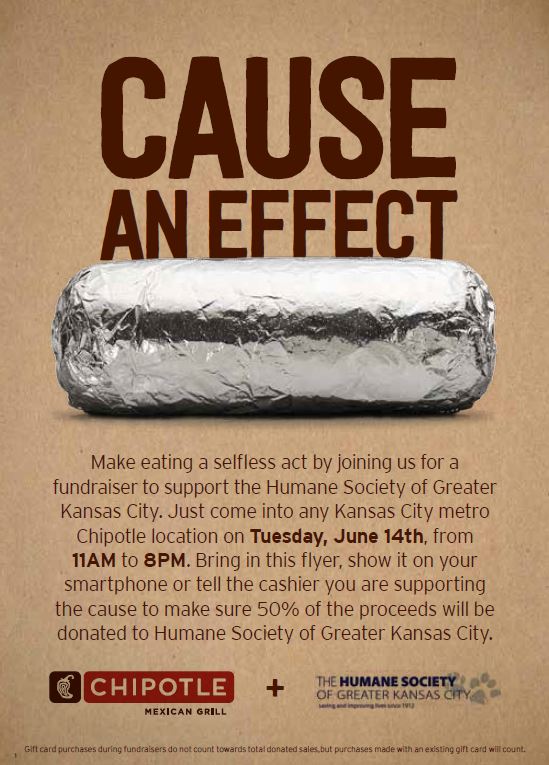
by Sharm | Jun 8, 2016 | Food & Drink, Local Restaurants, Restaurants, What You're Missing KC!

On Tuesday, June 14, half of all sales from KC-area Chipotle Mexican Grill restaurants will benefit the Humane Society of Greater Kansas City (HSGKC).
Between 11 a.m. – 8 p.m., 40 restaurants across Kansas City and Kansas will donate 50% of all proceeds to their respective local humane societies. In KC, this means that as long as long as you bring in the flyer, show the social media posts or simply mention the fundraiser, half of the money paid for their lunch or dinner will help animals at the HSGKC.
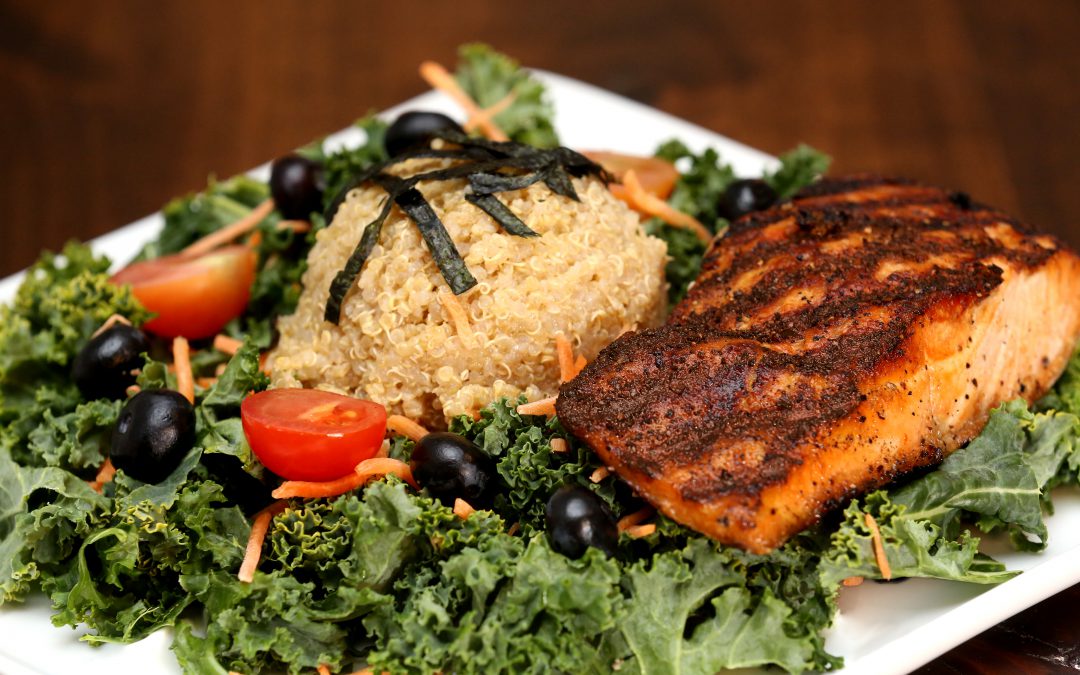
by Sharm | Feb 21, 2016 | Articles, Food & Drink, Kansas City, Restaurants, What You're Missing KC!
 February is American Heart Month and KC can residents can participate by dining out and eating heart-healthy. Thanks to Shawnee Mission Health’s (SMH) partnership with several area restaurants, diners will be able to order dishes that are deliciously good for the heart.
February is American Heart Month and KC can residents can participate by dining out and eating heart-healthy. Thanks to Shawnee Mission Health’s (SMH) partnership with several area restaurants, diners will be able to order dishes that are deliciously good for the heart.
Throughout the month of February, Grand Street Café, Blue Moose Bar & Grill, Barley’s Brewhaus, Story, Tavern at Mission Farms, Tavern in the Village and YaYa’s Euro Bistro will offer dishes that are low in fat and sodium and other ingredients that may increase risk of heart disease.
For each heart-healthy dish enjoyed by consumers, these restaurants will donate 10 percent to the Shawnee Mission Heart & Vascular Center to support various programs throughout the community, including CPR education in schools, women’s heart health and more.
The heart-healthy dishes being featured by SMH’s restaurant partners throughout February include:
· Roasted Beet Panzanella Salad with spiced cider braised apples, candied walnuts, goat cheese, toasted walnut raisin bread, arugula with an apple cider vinaigrette (Grand Street Café, Lenexa and Plaza)
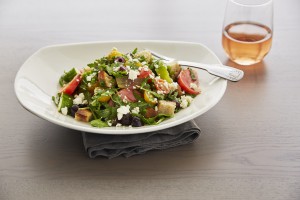
· Superfood Kale Salad with Grilled Salmon with tender kale, carrots and cherry tomatoes tossed in homemade sesame soy ginger vinaigrette, topped with soy ginger quinoa, blueberries, dried nori and grilled salmon (Blue Moose Bar & Grill and Barley’s Brewhaus Kansas City metro locations)
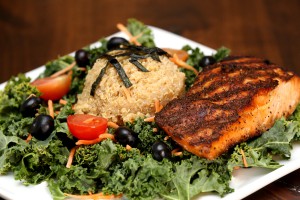
· Arctic Char with hen-of-the-woods mushrooms, broccoli, jasmine rice and a mushroom cream sauce (Story, Prairie Village)
· Fresh Grilled Salmon topped with pineapple salsa over a bed of sautéed kale and quinoa with grilled asparagus and red bell peppers (Tavern at Mission Farms and Tavern in the Village)
· 5 Grain Idaho Trout Salad with quinoa, amaranth, kaniwa, millet, farro, curry vinaigrette, lacinato kale, baby spinach, orange supreme, blood orange gastique, roasted butternut squash and grilled Idaho trout fillet (YaYa’s Euro Bistro, Overland Park)
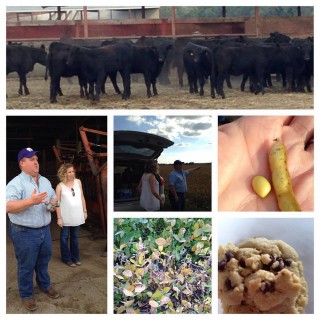
by Sharm | Nov 11, 2015 | Farming, Kansas City, What You're Missing KC!, Wichita
McPherson, Kansas is home to Sawyer Land and Cattle where Derek and Katie Sawyer grow soybeans and are raising cattle for steakhouse quality beef. I visited this farm while attending a three day farm tour across Kansas which you can read about here.
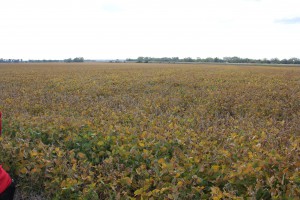
Sawyer’s Soybean Field
The Sawyer family has been farming for 80 years and have benefitted from the technology advances of farming. They buy their soybeans from Pioneer which is a GMO seed. They compare Monsanto is to farmers as Apple is to consumers, meaning we don’t have to buy an iPhone or they do not have to buy a GMO seed but with all the all the work they have done to put the technology in place to make their crops better, it is hard not to take advantage of that.
Their soybeans are grown for mostly for feed which they sell on a global market. Being a GMO seed makes them a bit more pest resistant which means they are not treated with pesticides very often. Derek explained that if a pesticide is used there is a waiting period after the pesticide is applied before the plat can be harvested which helps ease my conscious a bit.
Those of us on the tour who are against pesticides and GMO grilled him on some issues concerning GMO, pollution and other environmental factors and asked how he felt about in terms of it affecting his own young family with another on the way and if was he concerned about risks.
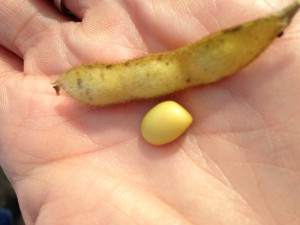
Soybean and pod
His response was “Obviously it hard to predict the future, but from what we knows now this is the best way we can produce food for the general public.” He did note that before having children he did not think so much about the food as it was feeding the masses, but now that he is feeding it to his own son does take more things into consideration. He notes that it is always going to be a challenge to prove anything is 100% safe but with what he knows now and the practices he uses, he would have no concerns that it is anyway unsafe to feed his family and does.
Just down the street is Derek and Katie’s cowherd where they raise beef for high end restaurants and steakhouses where you pay $40 to $50 for one steak.
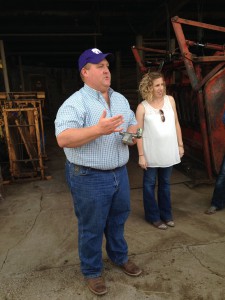
Derek and Katie Sawyer
We had the chance to meet their new heard he just received the day before we visited. The cows were a little fussy as they were just separated and wanted their Momma’s. This weaning process makes the calfs fussy for about 3 days and then all is good. It is also the best way for both momma and calf, as the momma would continue to nurse draining her of all her nutrients and the calf needs to learn to eat the grain to grow properly.
Although, the Sawyers grow soybeans for feed, they do not typically feed their soybeans to the cattle as they don’t possess the ability to grind the beans. The cattle are fed some type of mixture of corn, grasses, hay/alfalfa and distillers (an ethanol by-product). All of this except for the distillers is grown on their farm and remains on their farm from the field to the feed bunk. The exact feed mix is determined by the gender, age and nutritional needs of the animal.
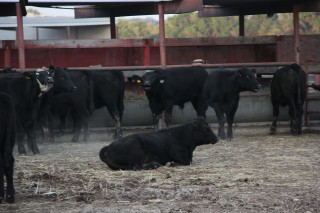
Sawyers Cattle
Derek runs about 600 calfs a year and once the cows are around 600 pounds they are custom grazed throughout the spring and summer in small towns around Emporia, Kansas where they will beef up (no pun intended) to about 800 – 850 pounds. The cows are then taken to Ellinwood, Kansas to a feed lot for a 120 days where they will end up around 1300 pounds. The cows are then taken too Garden City or Dodge City for harvesting.
The calfs at Sawyer farms get a hormone implant in their ear that releases a small amount of estrogen that helps convert the feed to muscle. The controversy on the hormone use is it gets into the meat. Derek explained that a serving of a steak with estrogen will have about four nanograms of estrogen while the beef without only contains two. That seems pretty low for both as he mentioned cabbage has 15,000 nanograms! The hormone also helps the animal grow faster resulting in a more tender cut of beef.
As I mentioned earlier about the waiting period after pesticide has been applied to a crop, the same applies if an animal has been given antibiotics. The Sawyers take their responsibility very seriously about raising the best beef as possible and will never give a cow an antibiotic just for the heck of it but if a cow gets sick, it is their job to take the best care they can of that animal. If that means it needs an antibiotic on occasion to help the cow heal instead of just letting illness make it sicker and sicker they will do that. Kaite explained that taking care of the animal quickly also ensures the health of the others in the heard because just like kids can spread things at school the same can happen to a heard. Records and documents are also kept on which cow received what and when so there is never a question on anything.
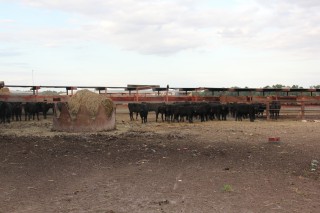
Sawyer’s Cattle
Just as it was at Good Farm (another stop on the tour), the Sawyer farm was clean and the cows had plenty of room to roam. I cannot say enough about the care the Sawyers give to the animals as they monitor them multiple times a day and during calving season it is a 24/7 operation so if a cow of calf needs assistance they are there to help. If needed, Katie even lets distressed calfs into their house and where she can warm them up with extra blankets and a hair blow dryer.
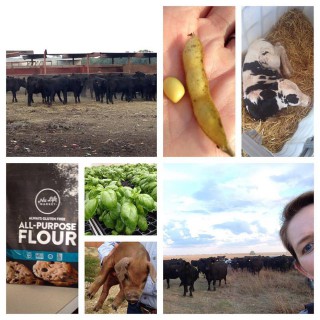
by Sharm | Nov 11, 2015 | Farming, Food & Drink, What You're Missing KC!, Wichita
If you happen to catch any of my #farmfoodtour pics on Instagram a few weeks ago, then you are aware of the great time I had when I was invited by the Kansas Farm Bureau to spend three days traveling across Kansas visiting local farms. All of these farms are impacting our nation as they supply their goods all across the country and beyond. I also learned many lessons about how are food is raised and truly had an eye opening experience.
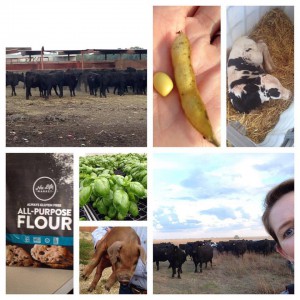
I love writing about local food and love meeting the farmers behind the food so I was excited to have the opportunity to experience this.
The trip consisted of a handful of writers and bloggers from the Midwest along with our hosts which was a representatives from Kansas Farm Bureau and The Kansas Soybean Association.
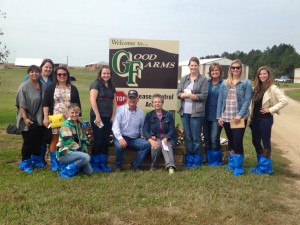
There was a lot of talk on the tour about the GMO controversy and although, I get the need for GMO for world hunger, the need for pesticide and virus resistant crops, etc…, I am anti GMO in the foods I eat, against factory farming and am adamant that our food should be labeled if it contains GMO.
So before the tour I have to admit I am the one who only listened to one side of the story and spent too much on organic produce.
There is still much debate on this subject but after this tour I am a bit more relaxed about things. I learned there are only eight GMO crops; corn, soybeans, cotton, papaya, canola, sugar beets, squash and alfalfa. I also learned there is rigorous testing done to ensure safety.
In addition to what I learned on the tour, I have been scouring sources to make the right decision for what I want to feed my family. Each side has a great argument and I am not an expert by any means so it really has to come down to a personal choice.
With a daughter recently diagnosed with some allergy and other health concerns, I am probably still going to stick with buying organic and non GMO foods but won’t freak out as bad if we get a GMO in our diet every now and then.
There is research that states GMO’s don’t cause allergies there is other research that says certain allergies did not exist until GMO’s where introduced. While we are on the topic of allergies there is now talk of making a GMO peanuts that would remove the allergen. There is also talk of a GMO wheat grain that would remove the gluten. For people who suffer from gluten issues or have peanut allergies does that make GMO a good thing?
My daughter is having some gluten issues so as a mom is that something I would try to help my daughter although I have been anti GMO, I don’t know. I would certainly have to do my homework. Again so much controversy that you have to choose what is right for you.
If gluten is an issue for you, do not miss reading about day two of the tour where we visited NuLife Market in Scott City, KS. They have amazing gluten free flour as well as other products.
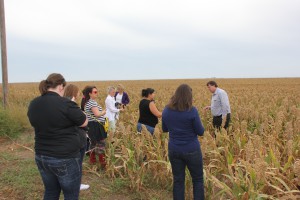
NuLife Market Sorghum Field
The labeling issue was another hot topic. I think it is super important for people to know what is in their food but we also need to educate ourselves as well. If you are trying to avoid GMO’s, know what crops are modified so you don’t have to fear if that cucumber is a GMO or not, because it is not one of the eight.
Before the tour I was adamant that GMO foods need to be labeled. After the tour I learned how much labeling laws would increase food cost and no one wants that. I decided that if the labeling is not going to happen then I need to educate myself on what crops are modified, and buy organic when I am not sure. There is already organic and non GMO labeling available that can probably help make the decision I need, so I don’t know that I am such a stickler on that topic anymore.
Other hot topics included antibiotic use, organic produce and crops as well as grass fed beef.
What about grass fed beef? Well, all beef is grass fed because they graze in the pastures. How it is finished is the difference. This is not too much of a hot button for me as my father in law raised cattle and gave them grain and that is all we ate. He recently quit raising the cattle so now I buy organic beef, but do not necessarily focus on grass finished or not. Grass finished has more omega 3 than grain finished but not enough to make a difference in your diet, so if you are looking for more Omega 3 eat some salmon or take a supplement.
What about antibiotics? All of the farms we visited do not give their animals antibiotics just for the heck of it and Good Farm that raises pork does not use any at all. The farmers that do use them explained that they are only used if medically necessary. Just as we get sick and occasionally need one, so do the animals. I also learned that there is a stringent documentation process on what animal got, how much and when it was. There is also a waiting period before the animal can be processed after an antibiotic is administered to make sure it is out of its system.
What about organic? Before the tour I envisioned non organic produce being doused with chemicals and then picked and put on the grocery store shelves. After the tour I am a little less concerned. Farmers have guidelines they have to adhere too on many levels and pesticide use is one of them. There is a certain waiting period they have to follow before they can harvest the crop after a pesticide has been applied. Does this make the fruit any safer to eat? I don’t know but it makes me feel a little better knowing there has been time for rain-showers and other environmental elements to shake off some the residue.
I appreciate that Cal-Ann Basil Farm we visited on day one does not use any synthetic pesticides since that is the brand I buy. I was happy to learn about the waiting period process on harvesting after pesticide use but will still buy organic especially the produce listed on the dirty dozen list because that is what works for me. I will say that knowing what I do now will help me not be so concerned if I see my son eating a non organic apple or knowing my daughter is not getting organic produce in the dining hall while she is away at college.
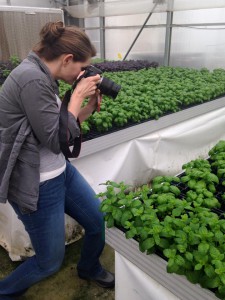
Me photographing some basil
The last issue we will tackle is Factory Farming. When I hear the term factory farm I envision hoards of pigs or cattle crammed into a tiny pin covered with gunk and who knows what else. The McCarty Family Farms we visited that produces milk for Dannon Yogurt is considered a factory farm and it was a total 360 from what I had in mind. You can read more about the McCarty Dairy on day three of the tour.
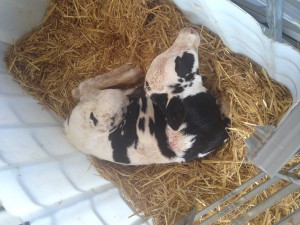
Newborn Calf at McCarty Family Farms Dairy
I cannot say enough about everything I learned and how compassionate these farmers are to make sure the crops they are growing and the animals they are raising meet the highest quality standards. It is truly is all about family and they care for their families as much as we do ours and are feeding them just like us so they want to produce the best food possible in the best way they know how.
I wish to thank the Kansas Farm Bureau and all the incredible farmers for this amazing experience. You can read more about the farms in the links below.
Day one: Cal-Ann Farms, Good Pork Farm, Sawyer Land and Cattle.
Day two: Nu Life Market
Day three: McCarty Family Farms, Blythe Angus Ranch
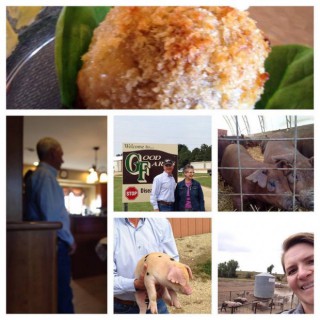
by Sharm | Nov 11, 2015 | Farming, Food & Drink, What You're Missing KC!
Good Farms is raising antibiotic free pork in Olsburg, Kansas and these little piggies are going places!
Good Farms was the second stop of the first day of the three day farm tour I took across Kansas which you can read about here.
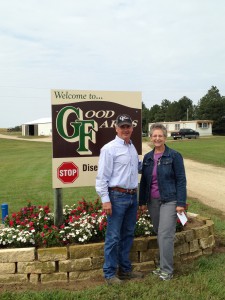
Craig and Amy Good
Craig and Amy Good are the proud owners of this hog farm and incredibly gracious hosts. They raise pigs for Heritage Foods USA. The pigs are raised without antibiotics and are well taken care of. I have to admit I was a bit nervous as I envisioned seeing a bunch of dirty pigs all crammed into a pin covered in who know what but that was not the case at all.
After Craig and Amy graciously invited us into their home to tell us about the farm and made us an appetizer of Ground Pork Meatballs with Gorganzola on Greens, that were absolutely delicious by the way, they gave us some cute blue booties to keep our shoes clean and took us out on the tractor to visit the little piggies.
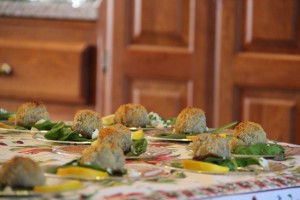
Pork Meatballs
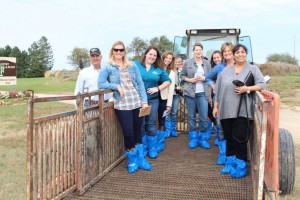
The farm was immaculately clean and the baby piglets are housed in a large barn area.
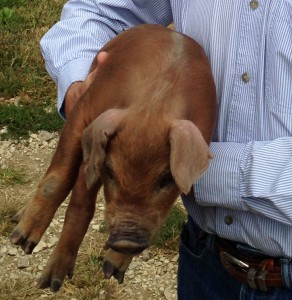
The children aged ones as I called them where free to run around in together in an extremely large covered pen carpeted with fresh hay. The grown adults have a separate area as well.
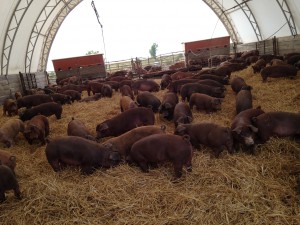
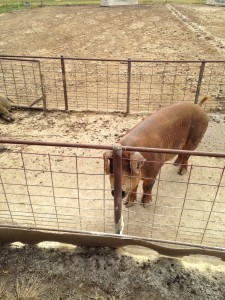
Craig and Amy are very conscious about producing the highest quality pork they can and to do that they keep the operation rather small to selling only about 1,000 pigs a year.
Heritage Foods is a company that connects chefs, restaurants and foodies that are looking for animals that have heritage genetics, are antibiotic free and raised on pastures to farmers that use these practices.
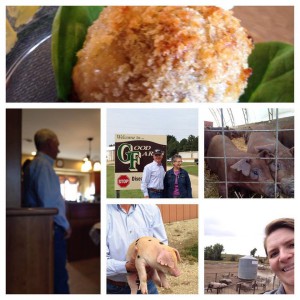
Celebrity chefs Mario Batali and Tom Colicchio use Good’s pigs as well as some pretty big name restaurants like Carnevino in Las Vegas and Fatted Calf in Napa Valley. Who knew that little piggy from Kansas was going to make it big time when he went to market. The market is close too, the pigs actually go to Paradise to be processed. Paradise Meat Locker that is, which is just up north in Trimble, MO.
You can order cuts of Good Farms pork and (beef once a year in the spring) at Heritage Foods USA. If you specifically want their meat you can request it, otherwise the order will be filled with whatever breeds Heritage chooses. All the pork on the Heritage website is family farm raised and none of the pigs have been given antibiotics.
If you are looking for a whole or half hog they can usually accommodate that from the farm to a local locker, but do not sell single cuts or bundles. Contact Craig and Amy Good for more information on that.
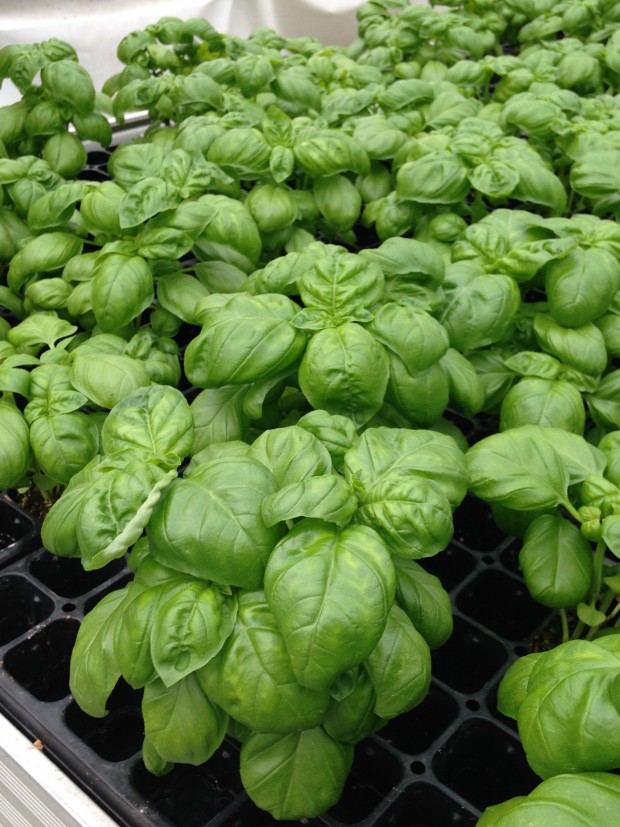
by Sharm | Nov 11, 2015 | Farming, Food & Drink, Food Finds, Kansas City, What You're Missing KC!
Cal-Ann Farms in Basehor, Kansas was the first stop on a recent three day farm tour I took across the state of Kansas. Myself along with a handful of other writers and bloggers were given the chance to visit six Kansas farms over three days and what we saw and learned was amazing. You can read more about the tour here.
This family owned basil farm produces almost all of the fresh Living Basil plants you see in the major grocery store chains in the Kansas City metro.
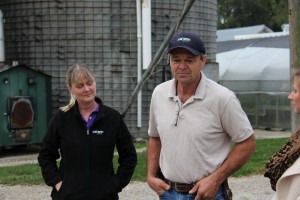
Jeff and Pam Meyer of Cal-Ann Farms
Jeff and Pam Meyer use hydroponics to grow basil, wheatgrass and few other fresh herbs year around without any pesticides. Hydroponic means no soil so Cal-Ann utilizes peat to keep the plant’s roots contained and moist while the plant still receives all its nutrients from the water.
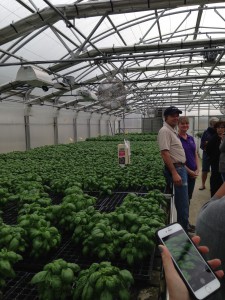
Cal-Ann Farms
Cal-Ann is named after Jeff’s parents Calvin and Annette Meyer who originally started Cal-Ann Farms as a dairy.
From seed to delivery to the store takes about 4 1/2 weeks. The basil is hand delivered to most of the major grocery store chains in the area. Cal-Ann Living Basil is the brand I buy so it was such a joy to see where my food comes from and meet the farmers that grow it.
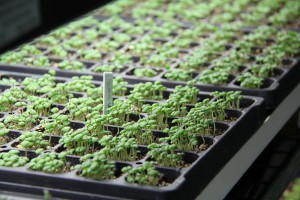
Cal-Ann Farms Basil
Jeff and Pam are absolutely amazing and their love for growing basil shows. The farm is organized, clean and there are many measures in place to keep the herbs safe.
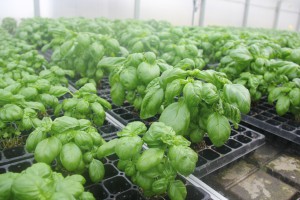
Cal-Ann Basil

Me photographing some basil
I had a great time on the tour and the basil scent was delightful. I’m also excited for a new fresh pesto product coming soon from Cal-Ann. Jeff and Pam let the cat out of the bag that they have been working on a homemade pesto using their own local basil that will be available in stores by the holidays!
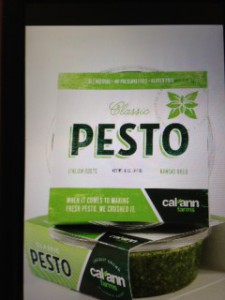
Cal-Ann Farms Basil Pesto
If you have ever made pesto before it is not terribly hard but does take a food processor and sometimes tricky to get the ratios of all the ingredients right making sure the garlic does not overpower the basil. This product will be a great way to have fresh basil pesto year around without any of the work.
From Basehor we made our way to Olsburg, KS where we went to Good Farm.
































